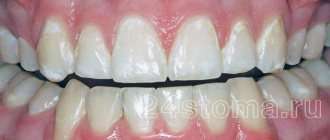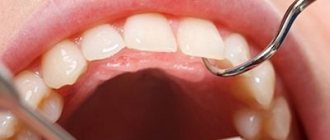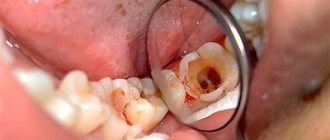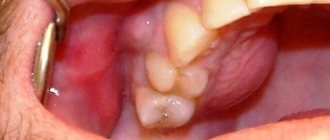An inflammatory formation affecting the upper part of the tooth root is called granuloma. It is formed during the development of periodontitis. Tooth granuloma is tightly attached to the root, being the initial stage of a granular cyst (cystogranuloma), from which it differs, in fact, only in its slightly smaller size. If the formation is ignored and not treated, it will begin to increase.
Tooth granuloma: symptoms of the disease
Only a doctor can make a diagnosis based on an x-ray, where a darkening will be visible in the root area. Any darkening in the image is a sign of the presence of a cavity, but if a granuloma occurs, it means that periodontitis, which is chronic in nature, begins to develop.
For a long time, the tooth may not bother a person at all. Sometimes pain may occur when biting or when eating hot food: these are the first signs of the development of chronic periodontitis. An exacerbation of the disease is observed during periods of weakening of the body's immunity: then the pain intensifies significantly, which is especially noticeable when biting. During such periods, as a rule, the gums become swollen, and in the area of inflammation it becomes painful to touch.
Tooth cyst: symptoms
If a dental cyst occurs, there may be no symptoms at all for a long time. In this case, jaw cysts are diagnosed accidentally, for example, during a routine X-ray examination before the start of prosthetics (usually a panoramic photograph of the teeth is taken for this - an orthopantomogram). But minor symptoms may still occur. For example, there may be periodic minor pain when biting on the causative tooth or slight pain when pressing on the gum in the projection of the tooth root.
Moreover, the patient will feel such symptoms inconsistently, but only periodically. For example, they can occur after hypothermia, against the background of decreased immunity and colds. In very rare cases, sharp pain may occur when biting on the causative tooth, against the background of which swelling of the gums and even soft tissues of the face may also be observed. Against the background of an exacerbation, slight mobility of the tooth with a cyst may also appear. Also, as a rule, such an exacerbation may be accompanied by a slight fever and weakness.
In some cases, a dental cyst can be suspected not only by these secondary signs. Sometimes you can even see it, of course, if it reaches a large size. If left untreated, the size of the cysts slowly increases, which is associated with the constant production of pus into the cyst cavity. An increase in the amount of pus in the cyst cavity leads to an increase in the pressure of the cyst on the walls of the bone cavity surrounding it. Under such pressure, the bone tissue is slowly resorbed and the cyst expands. I have operated on a number of patients whose cysts reached 3-4 cm in diameter.
On the upper jaw, root cysts increase in size much faster than on the upper jaw. This is due to the fact that the bone tissue of the upper jaw is softer and more porous in structure, and therefore its resorption always occurs faster. If a root cyst occurs in the premolars and molars of the upper jaw (teeth 4-5-6-7-8), the cyst may even occupy the entire volume of the maxillary sinus, and removal of the dental cyst in this case will require a maxillary sinus. In some cases, large root cysts may be visible during examination of the oral cavity, and not just on a targeted or panoramic x-ray.
Root cyst on the upper jaw (view in the oral cavity) –
Please note that, as in this case, the cyst deformed the hard palate. Such deformations can be observed not only in the palate, but also on the anterior side of the alveolar process of the upper and lower jaw. Very often, large cysts lead to complete destruction of bone tissue on the anterior surface of the alveolar process of the jaw (in the projection of the root of the causative tooth). And it turns out that under the mucous membrane in this area there will be a fibrous membrane of the cyst. In this case, during palpation you will not feel the hard bone; the finger will fall inward a little.
In what cases might you suspect you have a root cyst? –
Firstly, if you periodically experience discomfort or slight pain in one of your teeth when biting (in this case, gentle tapping on the tooth will also cause discomfort). But such symptoms are usually characteristic of apical periodontitis, which, by the way, also needs to be treated urgently. But what is not typical for ordinary apical periodontitis, but is typical for a root cyst, is pain on palpation of the gums in the projection of the root of the causative tooth.
Therefore, if there is discomfort in one of the teeth when biting, you can palpate (press) with your finger on the gum in the projection of the root of this tooth. Pain when pressed is highly likely to indicate the presence of a cyst at the root of the tooth (24stoma.ru). This diagnosis may also be supported by the presence of a dense or soft “bulging” of the gums in the projection of the root of the causative tooth, which can occur when the root cyst reaches a large size.
Why does granuloma appear on the root of a tooth?
At the tops of the roots, such formations can appear for several reasons:
- Poorly performed treatment of pulpitis. If caries is started, the affected cavity gradually becomes quite deep. When microorganisms enter the pulp, its inflammation begins, accompanied by acute pain, which may stop over time, indicating the death of the nerve.
But the development of the disease does not end: bacteria through the root canals extend beyond the boundaries of the affected tooth, as a result of which a focus of inflammation appears near the upper parts of the roots, called periodontitis. The further course of the disease can occur according to several scenarios, one of which is the formation of granuloma.
It is necessary to understand that a tooth with a granuloma does not necessarily have to be affected by caries, since the root can become inflamed near a tooth that has already been treated. If the doctor has not completely removed the tissues affected by caries by placing a filling on top of them, then there is a high risk of developing pulpitis with the subsequent formation of granuloma.
- Filling of root canals performed with violations. A granuloma that appears on the root of a tooth whose canals were filled some time ago indicates the unsatisfactory quality of the procedure performed. Due to inattention, haste or inexperience, the doctor could not fill the canals to the very top. Dentists often refuse to admit their own mistake, because in this case they will have to treat the tooth for free. Such unfortunate specialists can evade until the last minute, pretending that they do not understand the causes of pain, recommending taking a course of antibiotics.
Reasons for the development of pathology
There are two reasons for the development of granulomas on the root of a tooth.
1. Untreated pulpitis. The development of caries leads to the appearance of a deep cavity in the tooth. Pathogenic microorganisms enter the pulp, it becomes inflamed, and severe pain appears. Lack of medical care leads to the gradual death of the pulp. Bacteria penetrate beyond the tooth through root canals. A focus of inflammation appears at the apex of the root. We are talking about periodontitis.
A deep carious cavity in this case is not always observed. Inflammation can develop internally when secondary caries appears under the filling.
2. Poor quality endodontic treatment. Granuloma can develop at the root of a tooth in which root canal filling was previously performed. Usually there is underfilling: the doctor has not completely filled the canals with material. In the remaining voids, pathogenic bacteria develop, and the tissues surrounding the root react with inflammation.
These causes cause most cases of granuloma formation. But there are others, less common:
- poor quality orthodontic treatment;
- previous dental trauma;
- other inflammatory diseases - tonsillitis, abscess, etc.
In the latter case, the infection enters the tissues through the blood or lymph flow.
Ask a Question
Diagnosis of granuloma on the tooth root
At the early stage of development of the disease, it will not be possible to notice any visual changes. The first signs of pathology become noticeable as the size of the infected area and the amount of pus increase.
To treat the disease with therapeutic methods, it is necessary to examine the affected area in detail: a complete picture of the granuloma must be obtained, which will allow one to detect key signs of the disease that differ from other diseases.
When suppuration occurs, the gums become very red and swollen, and pain appears, which can radiate to the head area in general and the ear in particular. This is the first symptom that should make you wary.
The following methods can be used to make an accurate diagnosis:
- use of classical x-rays;
- the use of radiovisiography or, in simpler terms, computer x-ray.
In the picture, the affected area looks like a dark spot with a clear border in the upper part of the tooth. The size of the spot indicates the following:
- 5-8 mm – the probability of having a dental granuloma is high;
- more than 8 mm – formation in the form of a cyst.
In rare cases, a large granuloma, up to 1.2 cm in size, may occur. Therefore, X-rays may not be enough for diagnosis: it is recommended to perform a biopsy of tissue cells from the area affected by the disease.
In most cases, granuloma is discovered during treatment of other dental diseases: the doctor may pay attention to increased swelling and swelling of the gums. In addition, the bone tissue near the top of the tooth may also bulge.
An increased risk of developing granuloma is observed in patients with crowns and pulpless teeth. Such people are advised to undergo regular examinations in order to promptly identify any changes affecting the gums and teeth.
Tooth granuloma: treatment
Usually treatment is only therapeutic in nature, but its strategy may vary depending on whether the canals have been filled before.
- If the canals have not been filled, the tissues affected by caries are drilled out, and the old filling is removed. This is required to carry out high-quality mechanical treatment of the canals, which are expanded and treated with antiseptic agents. If the granuloma is small (formations up to 3 mm are considered such), then the canal is sealed immediately. If the size of the granuloma exceeds 3 mm, the treatment period increases, since it is necessary to put a medicine into the canal, which includes potassium hydroxide - this substance leads to a decrease in the granuloma or even to its complete disappearance. A temporary filling is placed for the period the medication is placed (approximately 2-3 weeks). Then a repeat x-ray is taken, which should clearly show a significant reduction in the inflammatory formation. If the dynamics are obvious, the canals are sealed and a permanent filling is placed.
- If the canals have been filled, then the first stage of treatment is their unsealing. The further sequence of actions is similar to that described in the previous paragraph. The only thing is that if there is a crown on the tooth, it will have to be removed, and after the treatment is completed, it will have to be made and placed again. Some patients do not want to spend money on re-installing a crown: the solution is to perform a root resection operation, when the upper part with the granuloma attached to it is cut off through a small incision in the gum.
Tooth cyst: treatment
If you have a cyst on the root of a tooth, treatment can be conservative (therapeutic) and surgical. Conservative treatment will consist of treating the cyst with a special medicinal paste based on calcium hydroxide, which will temporarily fill the root canals. Accordingly, if the root canals have not been filled, the tooth is opened and the root canals are mechanically treated. If the root canals have already been sealed, but poorly, they are first unsealed.
Below we will show how therapeutic treatment of a dental cyst is carried out using a specific example. It should be noted that good results with conservative therapy can be achieved even when treating fairly large cysts. However, there are situations where conservative therapy is less optimal than surgical removal of the cyst.
Surgical treatment is reasonable if...
- If the root canal is filled, but there is a pin in it, and there is a risk of fracture of the tooth root when removing the pin from the canal.
- If the root canal is filled, and the tooth has an artificial crown or is the support of a bridge (after therapeutic treatment of the cyst, the crowns will have to be redone, and this costs money).
- For large cysts.
- If the cyst arose as a result of perforation of the tooth root.
- If the cyst often suppurates, for example, every time you try to temporarily fill the root canals with medicinal paste.
A prerequisite (including in the presence of a pin and a crown) is that the root canal must be well sealed for at least 2/3 of its length. This will allow you to cut off the root apex with the unfilled part of the canal, removing it along with the cyst shell, and at the same time maintaining sufficient length of the root so that it can withstand the chewing load. A very important point is the convenience of surgical access, so surgical removal of a cyst is rarely performed, for example, in 6-7 teeth.
Therapeutic treatment of cysts using a specific example -
Let’s say right away that this method of treatment is very long (at least 2-3 months), it will require numerous visits to the dentist, and it is also the most financially expensive. The sequence of actions will be as follows (we will describe the main stages below):
- Working with tooth root canals – if the root canals of the tooth have not been previously filled, then at the first stage the dead pulp is removed from the tooth and instrumental treatment of the root canals is carried out. If the root canals have already been filled, then they are first unsealed. In this case, the cyst arose due to insufficient filling of the root canal to the root apex (Fig. 8).
Because the canal was previously sealed, then it must first be unsealed, which was done (Fig. 9). In fact, in this situation, it was much easier and cheaper for the patient to perform a resection operation. It would last about 30 minutes, and you could forget about the cyst. But the patient refused surgical treatment due to fear.Example of treatment of a root cyst (Fig. 8-12) –
- Medicinal treatment of canals - the cyst contains pus, therefore, after unsealing the canals or removing the pulp, numerous rinsing of the root canal with antiseptics is required.
- Temporary filling of the canals with medicinal paste - first, using special instruments, a medicinal substance is removed from the apex of the root (directly into the cavity of the cyst), which has a powerful antiseptic effect. For this purpose, a paste based on calcium hydroxide is used. The same substance is then used to temporarily fill the root canal (Fig. 10).
- Repeating points 3 and 4 - if the cyst is large, then over the next few months you will need to make a couple of visits to the dentist. This is necessary to change the medicine, as well as to take a control x-ray to assess the dynamics of the reduction of the cyst.
- X-ray control – the effectiveness of treatment is assessed. A significant reduction in the size of the cyst on x-ray indicates the effectiveness of the therapy (the structure of the newly formed bone is even visible in the image), and in this case, you can proceed to the next stage - permanent filling of the root canals.
- Permanent filling of the root canals - if a decrease in the size of the cyst is noticed over the course of several months during treatment, then the root canals are finally filled, usually with gutta-percha (Fig. 11). Immediately after this, you can begin to restore the crown part of the tooth.
After the root canals have been completely filled and a filling has been placed, the patient must visit the doctor every few months and take a control x-ray. The image clearly shows the dynamics of cyst reduction and bone tissue restoration. Compare the X-ray image in Fig. 12 (taken 2.5 months after the start of treatment) with the image before the start of treatment in Fig. 8. The naked eye can see a reduction in the size of the cyst and restoration of the bone beams.
Emergency care for exacerbation of inflammation -
We have already said above that dental cysts are usually characterized by a chronic, sluggish course of the inflammatory process. However, in some cases, a sharp exacerbation of the process may occur - with the appearance of acute pain when biting on a tooth and/or swelling of the gums in the projection of the cyst. When a patient goes to the dentist due to an exacerbation, the tooth is immediately opened to allow the drainage of pus from the cyst cavity (through the root canals). You can see how this happens in video 1.
If there is swelling on the gum, the patient is sent to a dental surgeon to make an incision in the gum. You can see how the gum incision is made in video 2. After this, the tooth is left open, and the patient is prescribed antibiotics, antiseptic rinses, and non-steroidal anti-inflammatory drugs.
Well, in conclusion, I would like to say about how dangerous a dental cyst is if it is not treated. Root cysts slowly increase in size, and imagine that there is a 2-3 cm cavity filled with pus in your head. A growing cyst, for example, can engulf the roots of neighboring teeth, which will require filling the canals in them as well. In addition, the cyst can grow into the maxillary sinus and do many other bad things. We hope that our article on the topic: Dental cyst treatment was useful to you!
Sources:
1. Dental education of the author of the article, 2. Based on personal experience as a dentist, 3. National Library of Medicine (USA), 4. “Outpatient surgical dentistry” (Bezrukov V.), 5. “Therapeutic dentistry: Textbook” ( Borovsky E.).
Granuloma between tooth roots: treatment with antibiotics
The number of people putting off visiting a doctor until the last minute is large. There are many reasons for this: fear of pain (although modern means of anesthesia make it possible for the patient to feel nothing at all during treatment procedures), lack of free time, and reluctance to part with money. But all these reasons and excuses come to naught when the pain becomes unbearable, becoming chronic. As practice shows, as soon as a person does not sleep for a couple of nights, the issue of the need to visit the dentist is resolved by itself.
However, many people try to cure granuloma on their own using strong antibiotics, which is basically impossible. Antibiotics may be prescribed to relieve inflammation and stop the formation of pus, but nothing more. But the action of antibiotics may not affect pathogenic microorganisms located in the root canals, and it is the infection in their unsealed areas that is the only reason for the formation of granulomas.
If a patient comes to the doctor with a suspicion of granuloma, and the doctor, driven by some of his own considerations, does nothing, recommending taking antibiotics, it is better not to delay time, but to immediately contact another dentist. Some doctors simply do not like to re-treat someone’s poorly treated teeth, since repeating the same operations takes much more time, while others, if the patient comes back again, do not want to admit that they made a mistake, which for them is tantamount to realizing their own lack of competence.
Tooth granuloma: surgical treatment
If therapeutic treatment does not help, then surgery comes into play: the operation is performed in the presence of a destructive process affecting the gums, and anesthesia (both general and local) is used to carry it out.
There are several surgical treatment options.
Root resection
Elimination of granuloma occurs in several stages:
- a passage to the top of the tooth opens by peeling off the gum shell;
- the root canals are cleaned and subsequently filled with medicinal substances;
- excision of the granuloma is carried out;
- the area is filled with synthetic fabrics;
- the tooth is filled.
On average, the operation takes about an hour.
Hemisection
If a tooth has many roots, then this procedure is prescribed (if there are complications that prevent the root from being saved).
The treatment procedure includes:
- removal of roots under the crown;
- filling the empty space between the roots with a special dental product;
- installation of a crown;
- monitoring the condition of the tooth using x-rays.
The method is simple, while the functionality of the tooth is preserved. If necessary, some time after the procedure, the patient can resort to prosthetics, provided that the root system remains healthy.
Cystotomy
The method is used when removal of large granulomas is required.
To implement it:
- a channel is created between the affected area and the oral cavity, through which pus absorbed by tampons is removed;
- after cleaning, the cavity is treated with antibacterial agents;
- sutures are placed;
- the cavity, free from suppuration, is filled with bone cells.
Measures to prevent granuloma after an extracted tooth
Preventive measures are aimed at preventing the development of the disease. They include:
- high-quality cleaning of teeth and gums on a daily basis;
- timely treatment of bleeding gums;
- regular visits to the dentist at least once a year (it is better to do this twice);
- replacing toothbrushes (old brushes accumulate bacteria that can provoke the development of the disease);
- contacting the dentist at the slightest pain associated with the gums or teeth;
- treatment of caries, periodontitis and pulpitis - quite often these diseases are the catalyst for the development of granuloma;
- the use of medicated toothpastes and herbal decoctions for rinsing;
- eating foods rich in calcium and other trace elements.
Complications after granuloma at the site of an extracted tooth
Lack of timely treatment and hope that the disease will go away on its own is fraught with serious consequences. Among the most common complications it is worth highlighting:
- development of periodontitis and further formation of a fistula;
- the occurrence of alveolitis is a consequence of the presence of an inflammatory process;
- formation of purulent flux;
- suppuration of the perimaxillary tissue;
- entry of pathogenic bacteria into the lymph nodes, from where they penetrate the cardiac system and internal organs (kidneys, liver and brain);
- development of facial asymmetry;
- the emergence of new foci of infection;
- infection of the body due to the penetration of pathogenic microorganisms into the blood vessels.
Timely removal of granuloma is a guarantee to avoid unpleasant health consequences.
Surgery
Surgical treatment of dental granuloma may be required only in a few cases:
- obstruction of the root canals - complex, tortuous structure, too thin, narrow canals;
- impossibility of unsealing channels;
- the presence of a pin in the root canal - attempts to remove it may cause injury;
- patient's reluctance to remove the crown.
Many patients prefer granuloma removal because they do not want to resort to long-term treatment and remove a good crown. In this case, an apical resection operation is performed - part of the root is removed along with the granuloma through a small incision in the gums. Less commonly used is hemisection - removal of one root of a multi-rooted tooth along with part of the crown. In this case, further restoration of the crown of the tooth with a prosthesis will be required.
In rare cases, it is not advisable to preserve a tooth with granuloma. For example, if the crown is severely damaged and cannot be restored. In this case, when removing a tooth, the doctor must remove the granuloma from the socket in order to prevent the development of inflammation.
If purulent complications develop against the background of a granuloma, it is important to get help from a doctor immediately. The specialist will provide first aid: relieve acute pain by opening the tooth. Previously sealed canals are opened, and purulent contents are subsequently removed through them. In this case, relief comes instantly.
If severe swelling of the gums or cheeks appears, this may be due to the release of inflammatory contents under the periosteum or oral mucosa. In this case, a small incision is made to drain the pus. Further treatment is possible only after relief of acute symptoms. Drug therapy will also be required - the doctor will prescribe a course of antibiotics. You should not take them on your own. Moreover, it makes no sense to be treated only with antibiotics in the hope that the inflammation will go away - they are not able to eliminate the source of the disease or even reduce it, it is important to take local measures to eliminate the inflammatory process.











